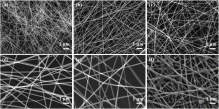© Copyright 2020 Foshan Membrane Technology Co., Ltd. All rights reserved. Sitemap
Electrospinning is a versatile technique to fabricate nanofiber filters with high PM2.5 removal efficiency and relatively low pressure drop. The eletrospun nanofiber filters may therefore be applied in buildings to reduce indoor exposure to PM2.5 and the associated adverse health effects. This study investigated the influence of various filter parameters, including fiber diameter, filter thickness, and packing density, on the PM2.5 removal efficiency. In this work, 25 nylon electrospun nanofiber filters with different filter parameters were prepared, and the PM2.5 removal efficiency of each sample was measured at five different face velocities. In total, 125 sets of measured data were obtained. The results show that the PM2.5 removal efficiency of nylon electrospun nanofiber filters was negatively associated with the fiber diameter, and positively associated with the thickness of the filter. However, there was no clear correlation between PM2.5 removal efficiency and packing density. This investigation further developed a semi-empirical model for predicting the PM2.5 removal efficiency of nylon nanofiber filters. The accuracy of the model was satisfactory with a median relative error of 7.9%.
电纺丝是一种制造纳米纤维过滤器的通用技术,该过滤器具有较高的PM2.5去除效率和相对较低的压降。因此,电纺纳米纤维过滤器可应用于建筑物中,以减少室内暴露于PM2.5以及相关的不良健康影响。这项研究调查了各种过滤器参数(包括纤维直径,过滤器厚度和堆积密度)对PM2.5去除效率的影响。在这项工作中,准备了25个具有不同过滤器参数的尼龙电纺纳米纤维过滤器,并在五个不同的表面速度下测量了每个样品的PM2.5去除效率。总共获得125套测量数据。结果表明,尼龙电纺纳米纤维滤池的PM2.5去除效率与纤维直径呈负相关,与滤池的厚度呈正相关。但是,PM2.5的去除效率和堆积密度之间没有明显的相关性。这项研究进一步开发了一个半经验模型,用于预测尼龙纳米纤维过滤器的PM2.5去除效率。该模型的准确性令人满意,中位相对误差为7.9%。

Published: 2020
Journal :BUILDING AND ENVIRONMENT
Impact Factor:5.847
Paper link: https://www.sciencedirect.com/science/article/abs/pii/S0360132319308418